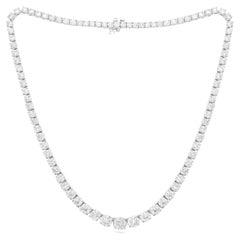Diamond Riveira Necklace
21st Century and Contemporary American Modern Choker Necklaces
Diamond, 14k Gold, White Gold
Diana M. Jewels for sale on 1stDibs
Located in New York City, esteemed fine jewelry house Diana M. Jewels was established in 1981 by Diana Musheev. A third-generation jewelry designer born in Riga, Latvia, Musheev is widely known for her exquisite earrings, engagement rings and necklaces that feature precious sapphires, emeralds and white or colored diamonds as well as the incredibly rare Paraiba tourmalines. The latter come from deep in the copper-rich mountains of Paraiba, Brazil, and are treasured as much for their extraordinary color as their scarcity.
Musheev, a GIA-certified gemologist and graduate of the Moscow School of Design, has been designing jewelry since she was 16.
At an early age, Musheev had already mastered the ability to envision how she might create adornments that would best accentuate a precious or semi-precious stone’s natural characteristics and create a flattering dynamic between the jewelry and the wearer. The designer inherited this gift from her mother and grandmother, who created custom jewels for the European elite. Musheev says her jewelry transforms those who wear it and proudly states that ”some women fear the fire and some women become it.”
Some of the most prestigious names in retail, such as Neiman Marcus and Saks, carry Diana M. Jewels collections. Musheev’s noteworthy clients have included Brian Wilson of The Beach Boys, Tina Knowles (mother of award-winning pop star Beyoncé) and music producer and former Columbia Records president Clive Davis.
Find Diana M. Jewels hoop earrings, cocktail rings and other accessories on 1stDibs.
A Close Look at modern Jewelry
Rooted in centuries of history of adornment dating back to the ancient world, modern jewelry reimagines traditional techniques, forms and materials for expressive new pieces. As opposed to contemporary jewelry, which responds to the moment in which it was created, modern jewelry often describes designs from the 20th to 21st centuries that reflect movements and trends in visual culture.
Modern jewelry emerged from the 19th-century shift away from jewelry indicating rank or social status. The Industrial Revolution allowed machine-made jewelry using electric gold plating, metal alloys and imitation stones, making beautiful jewelry widely accessible. Although mass production deemphasized the materials of the jewelry, the vision of the designer remained important, something that would be furthered in the 1960s with what’s known as the “critique of preciousness.”
A design fair called the “Exposition Internationale des Arts Décoratifs et Industriels Modernes” brought global attention to the Art Deco style in 1925 and gathered a mix of jewelry artists alongside master jewelers like Van Cleef & Arpels, Mauboussin and Boucheron. Art Deco designs from Cartier and Van Cleef & Arpels unconventionally mixed gemstones like placing rock crystals next to diamonds while borrowing motifs from eclectic sources including Asian lacquer and Persian carpets. Among Cartier’s foremost design preoccupations at the time were high-contrast color combinations and crisp, geometric forms and patterns. In the early 20th century, modernist jewelers like Margaret De Patta and artists such as Alexander Calder — who is better known for his kinetic sculptures than his provocative jewelry — explored sculptural metalwork in which geometric shapes and lines were preferred over elaborate ornamentation.
Many of the innovations in modern jewelry were propelled by women designers such as Wendy Ramshaw, who used paper to craft her accessories in the 1960s. During the 1970s, Elsa Peretti created day-to-night pieces for Tiffany & Co. while designers like Lea Stein experimented with layering plastic, a material that had been employed in jewelry since the mid-19th century and had expanded into Bakelite, acrylics and other unique materials.
Find a collection of modern watches, bracelets, engagement rings, necklaces, earrings and other jewelry on 1stDibs.
Finding the Right choker-necklaces for You
Vintage choker necklaces are elegant, alluring and stylish. Cameos, pearls, diamonds and other stones can decorate these necklaces, which come in single or multiple strands. Whether it is a statement piece or a delicate chain, these short necklaces always stand out and turn heads.
The history of the choker can be traced back thousands of years, with Sumerian examples discovered from 2600–2500 B.C. They endured as a popular form of adornment through the centuries, and during the French Revolution they took on a symbolic significance. Women wore ribbons around their throats to mark the passing of those killed by the guillotine. Soon, the plain ribbons were adorned with small cameos and other ornamentation.
European choker necklaces gained a salacious reputation in the 19th century when prostitutes were associated with black ribbons tied around the neck, such as the model in Édouard Manet’s Olympia (1863). Queen Alexandra, Princess of Wales, reversed the trend in the late 19th century by wearing a large pearl and diamond choker, reputedly to hide a scar.
Fashioned from gold, pearls and other precious stones and metals, chokers continued to be worn into the 20th century, alternately statements of wealth and rebellion. They experienced periods of revival in the 1920s, ’40s, ’70s and ’90s for both men and women.
Vintage chokers make a statement with an unmistakable air of femininity. On 1stDibs, find an alluring collection of vintage chokers today, including gold, sapphire and emerald chokers.
